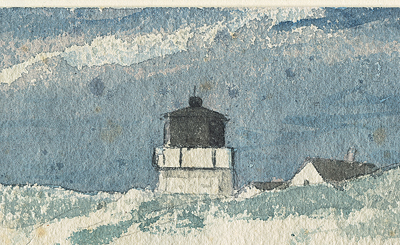Detail: Spots caused by mold in "unsized" areas
Boy in Boat, Gloucester is a good example of Homer’s forgiving attitude towards technical problems and mistakes. In the nineteenth century, many artists reported mold problems with Whatman papers—the type Homer favored. These sheets were infused with gelatin called size to retard the absorption of washes into the fibers; where microbial molds digested this material, invisible weakened or “unsized” areas remained. When watercolor was brushed on, these spots, having lost their barrier to moisture, preferentially absorbed the color, leaving uneven, dotted passages, seen in this work as dark blue spots across the sky. When the mold pattern emerged Homer, who rarely abandoned a sketch, nevertheless completed the work.
Detail of Boy in Boat, Gloucester, showing the dark blue spots resulting from mold activity that was present on the paper before Homer began to paint.

